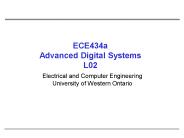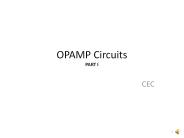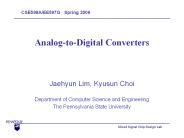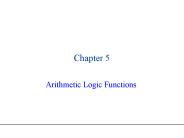Subtractor PowerPoint PPT Presentations
All Time
Recommended
Subtractors Module M8.2 Section 6.2 Subtractors Half Subtractor Full Subtractor Adder/Subtractor - 1 Adder/Subtractor - 2 Half Subtractor Full Subtractor Full ...
| PowerPoint PPT presentation | free to view
The attached narrated power point presentation attempts to explain the working principles of adders and subtractors.
| PowerPoint PPT presentation | free to download
EFFICIENT MODULO 2n+1 SUBTRACTORS FOR WEIGHTED OPERANDS Costas P. Efstathiou Digital Systems and Communications Lab Department of Informatics
| PowerPoint PPT presentation | free to view
More complex process than multiplication. E.g., when calculating logb(X Y) ... Share table-lookup part and some combinational parts in the above two computations ...
| PowerPoint PPT presentation | free to download
Design of Novel Reversible Carry Look-Ahead BCD Subtractor ... subtrahend is added to the minuend ?In BCD arithmetic ,instead of subtracting ...
| PowerPoint PPT presentation | free to view
Overview of the Circuit Multiplier Subtractor Comparator Multiplexer Block Diagram Functions Of Individual Parts Inputs: two, 16 unsigned bits each ( A and B ...
| PowerPoint PPT presentation | free to download
Adder/subtractor architecture for 2's-complement numbers. Signed-Magnitude vs 2's-Complement ... Signed-magnitude adder/subtractor is significantly more ...
| PowerPoint PPT presentation | free to download
Adders and Subtractors Author: edie Last modified by: Richard Haskell Created Date: 1/16/1999 4:15:10 AM Document presentation format: On-screen Show Company:
| PowerPoint PPT presentation | free to download
Combinational Logic Design Overview Binary Subtraction 2 s complement Extension to r s complement Subtraction with complements Binary Adders/Subtractors Signed ...
| PowerPoint PPT presentation | free to view
... Adder/Subtractor Serial Adder Control Logic Controller and Datapath Modules Three Techniques for Building Control Units Binary Multiplication Binary Multiplier ...
| PowerPoint PPT presentation | free to view
Fast Adder, Adder/Subtractor, Multiplier Circuits. Principle: ... whether multiplicand to be. added to incoming PP. or shift diagonally. Binary Multiplier: ...
| PowerPoint PPT presentation | free to view
Encoders. How to implement functions. using ROMs, PLAs, and PALs. 9/18/09. 3. Review: ... Encoders. Code Converters. Comparators. Adders/Subtractors ...
| PowerPoint PPT presentation | free to download
decoders, encoders, multiplexers, adders, subtractors, multipliers, comparators, etc. ... Need to consider the implementation of combinational systems with ...
| PowerPoint PPT presentation | free to view
Ripple Carry Adder ... Combined Adder/Subtractor. A single ripple-carry adder can perform both addition and subtraction, by ...
| PowerPoint PPT presentation | free to view
Table 17.1 Some features of the ANSI/IEEE standard floatingpoint number representation formats ... Fig. 18.1 Block diagram of a floating-point adder/subtractor. ...
| PowerPoint PPT presentation | free to view
Parallel Binary Adder ... Remember, a full adder adds single bits. All input bits are applied ... Don't build two separate units -- build one adder/subtractor ...
| PowerPoint PPT presentation | free to view
decoders, encoders, multiplexers, adders, subtractors, multipliers, ... If decoded each of the minterms based on binary weighting of each variable and ...
| PowerPoint PPT presentation | free to view
Tracking elements allow fringe-rate filtering. COMPACT ... NVSS and First Catalogues at 1.4GHz. Ryle Observations at 15GHz. VSA Source Subtractor at 33GHz. ...
| PowerPoint PPT presentation | free to download
For more classes visit www.snaptutorial.com I. OBJECTIVES 1. To test the operation of a 74LS74 D flip-flop and compare the operation with the predicted behavior 2. To test the operation of a 74LS112 J-K flip-flop and compare the operation with the predicted behavior 3. To measure propagation delays of a 74LS112 J-K flip-flop 4. To build and test an enhanced adder-subtractor II. PARTS LIST
| PowerPoint PPT presentation | free to download
Work through full subtractor example, page 123 ... Some aside comments. Saylor. Ground. Vacuum tubes (valves) Transister basics. How they make IC's ...
| PowerPoint PPT presentation | free to view
If they happen to be the same then activate ADDER circuit else activate SUBTRACTOR section. ... Activate ADDER Section ( Signs are Equal ). Step 6. ...
| PowerPoint PPT presentation | free to view
12-Bit Register Simulations. 16. PII Function - Layout. 17. Sinc Filter -Layout. 18. Timing and Power ... 12-Bit Register. 480. 16-Bit Subtractor. 448. 16-Bit ...
| PowerPoint PPT presentation | free to download
... look at new design for subtractor ... Need only adder and complementer for ... Set clock so changes allowed to occur before next clock pulse. Asynchronous ...
| PowerPoint PPT presentation | free to view
... circuit architecture (by drawing), Verilog code, test bench, simulation waveform ... C program that can generate the Verilog file of the adder/subtractor circuits ...
| PowerPoint PPT presentation | free to view
(Computer Architecture) * * Serial Divider Serial Divider ...
| PowerPoint PPT presentation | free to view
Computer Architecture I: Digital Design Dr. Robert D. Kent Logic Design Medium Scale Integration and Programmable Logic Devices Part II
| PowerPoint PPT presentation | free to download
The attached narrated power point presentation explores the potentials of summing and difference amplifiers circuits using OPAMPs.
| PowerPoint PPT presentation | free to download
CSE598A/EE597G Spring 2006 Analog-to-Digital Converters Jaehyun Lim, Kyusun Choi Department of Computer Science and Engineering The Pennsylvania State University
| PowerPoint PPT presentation | free to download
For more classes visit www.snaptutorial.com 1. Does a typical computer have any analog outputs? If so, what are they? 2. List three advantages of digital signal representation as compared to their analog representation. 3. Convert 126 x 10+2 to scientific and engineering notations.
| PowerPoint PPT presentation | free to download
or shift diagonally. H. V. RAVISH ARADHYA., R.V.C.E.. Array Multiplier: ... q i decides m j to be added or shifted diagonally. too much delay. Binary Multiplier: ...
| PowerPoint PPT presentation | free to view
For more classes visit www.snaptutorial.com 1. Does a typical computer have any analog outputs? If so, what are they? 2. List three advantages of digital signal representation as compared to their analog representation. 3. Convert 126 x 10+2 to scientific and engineering notations. 4. Make the following conversions: a. Convert 0.34 seconds to milliseconds.
| PowerPoint PPT presentation | free to download
1. Does a typical computer have any analog outputs? If so, what are they? 2. List three advantages of digital signal representation as compared to their analog representation. 3. Convert 126 x 10+2 to scientific and engineering notations. 4. Make the following conversions: a. Convert 0.34 seconds to milliseconds.
| PowerPoint PPT presentation | free to download
For more course tutorials visit www.newtonhelp.com 1. Does a typical computer have any analog outputs? If so, what are they? 2. List three advantages of digital signal representation as compared to their analog representation.
| PowerPoint PPT presentation | free to download
For more course tutorials visit www.newtonhelp.com 1. Does a typical computer have any analog outputs? If so, what are they? 2. List three advantages of digital signal representation as compared to their analog representation.
| PowerPoint PPT presentation | free to download
Logic Design with MSI Circuits MSI
| PowerPoint PPT presentation | free to view
Title: CS116-Computer Architecture Subject: Chapter 1:Computer Abstraction & Technology Author: Originally:Tod Amon / Modifed & Augmented:M.Malaty
| PowerPoint PPT presentation | free to download
For more course tutorials visit www.newtonhelp.com 1. Does a typical computer have any analog outputs? If so, what are they? 2. List three advantages of digital signal representation as compared to their analog representation.
| PowerPoint PPT presentation | free to download
For more classes visit www.snaptutorial.com 1. Does a typical computer have any analog outputs? If so, what are they? 2. List three advantages of digital signal representation as compared to their analog representation. 3. Convert 126 x 10+2 to scientific and engineering notations.
| PowerPoint PPT presentation | free to download
1. Does a typical computer have any analog outputs? If so, what are they? 2. List three advantages of digital signal representation as compared to their analog representation. 3. Convert 126 x 10+2 to scientific and engineering notations. 4. Make the following conversions: a. Convert 0.34 seconds to milliseconds. b. Express 0.0005 x 10-4 farads as picofarads.
| PowerPoint PPT presentation | free to download
For more course tutorials visit www.tutorialrank.com 1. Does a typical computer have any analog outputs? If so, what are they? 2. List three advantages of digital signal representation as compared to their analog representation. 3. Convert 126 x 10+2 to scientific and engineering notations. 4. Make the following conversions:
| PowerPoint PPT presentation | free to download
For more course tutorials visit www.newtonhelp.com 1. Does a typical computer have any analog outputs? If so, what are they? 2. List three advantages of digital signal representation as compared to their analog representation. 3. Convert 126 x 10+2 to scientific and engineering notations. 4. Make the following conversions:
| PowerPoint PPT presentation | free to download
For more course tutorials visit www.newtonhelp.com 1. Does a typical computer have any analog outputs? If so, what are they? 2. List three advantages of digital signal representation as compared to their analog representation. 3. Convert 126 x 10+2 to scientific and engineering notations.
| PowerPoint PPT presentation | free to download
For more course tutorials visit www.newtonhelp.com 1. Does a typical computer have any analog outputs? If so, what are they? 2. List three advantages of digital signal representation as compared to their analog representation.
| PowerPoint PPT presentation | free to download
For more classes visit www.snaptutorial.com 1. Does a typical computer have any analog outputs? If so, what are they? 2. List three advantages of digital signal representation as compared to their analog representation. 3. Convert 126 x 10+2 to scientific and engineering notations. 4. Make the following conversions: a. Convert 0.34 seconds to milliseconds. b. Express 0.0005 x 10-4 farads as picofarads. 5. The frequency of a signal is equal to the reciprocal of the signal’s period (f = 1/p). For a computer with a 2.4
| PowerPoint PPT presentation | free to download
1. Does a typical computer have any analog outputs? If so, what are they? 2. List three advantages of digital signal representation as compared to their analog representation. 3. Convert 126 x 10+2 to scientific and engineering notations.
| PowerPoint PPT presentation | free to download
For more classes visit www.snaptutorial.com 1. Does a typical computer have any analog outputs? If so, what are they? 2. List three advantages of digital signal representation as compared to their analog representation. 3. Convert 126 x 10+2 to scientific and engineering notations.
| PowerPoint PPT presentation | free to download
For more course tutorials visit www.tutorialrank.com 1. Does a typical computer have any analog outputs? If so, what are they? 2. List three advantages of digital signal representation as compared to their analog representation. 3. Convert 126 x 10+2 to scientific and engineering notations. 4. Make the following conversions: a. Convert 0.34 seconds to milliseconds.
| PowerPoint PPT presentation | free to download
For more course tutorials visit www.newtonhelp.com 1. Does a typical computer have any analog outputs? If so, what are they? 2. List three advantages of digital signal representation as compared to their analog representation. 3. Convert 126 x 10+2 to scientific and engineering notations.
| PowerPoint PPT presentation | free to download
For more classes visit www.snaptutorial.com 1. Does a typical computer have any analog outputs? If so, what are they? 2. List three advantages of digital signal representation as compared to their analog representation. 3. Convert 126 x 10+2 to scientific and engineering notations. 4. Make the following conversions:
| PowerPoint PPT presentation | free to download
1. Does a typical computer have any analog outputs? If so, what are they? 2. List three advantages of digital signal representation as compared to their analog representation. 3. Convert 126 x 10+2 to scientific and engineering notations.
| PowerPoint PPT presentation | free to download
... of 1 bit, 2 words, dual port SRAM results. M2: Team Paradigm ... 64x16 dual port SRAM --- core layout. M2: Team Paradigm. Floor plan Proposal. rom. shift reg ...
| PowerPoint PPT presentation | free to download
Digital Logic Design Lecture # 12 University of Tehran
| PowerPoint PPT presentation | free to view
Appendix A Author, Miles Murdocca ... Miles Murdocca and Vincent Heuring Chapter 3: Arithmetic
| PowerPoint PPT presentation | free to download
For more classes visit www.snaptutorial.com 1. Does a typical computer have any analog outputs? If so, what are they? 2. List three advantages of digital signal representation as compared to their analog representation. 3. Convert 126 x 10+2 to scientific and
| PowerPoint PPT presentation | free to download
echo cancellation Ian Hung 2B Computer Engineering University of Waterloo August 17th, 2001 Presentation Overview Squelching Echo in a Digital Cellular Network A ...
| PowerPoint PPT presentation | free to download
Chapter 5 Arithmetic Logic Functions
| PowerPoint PPT presentation | free to download
























































